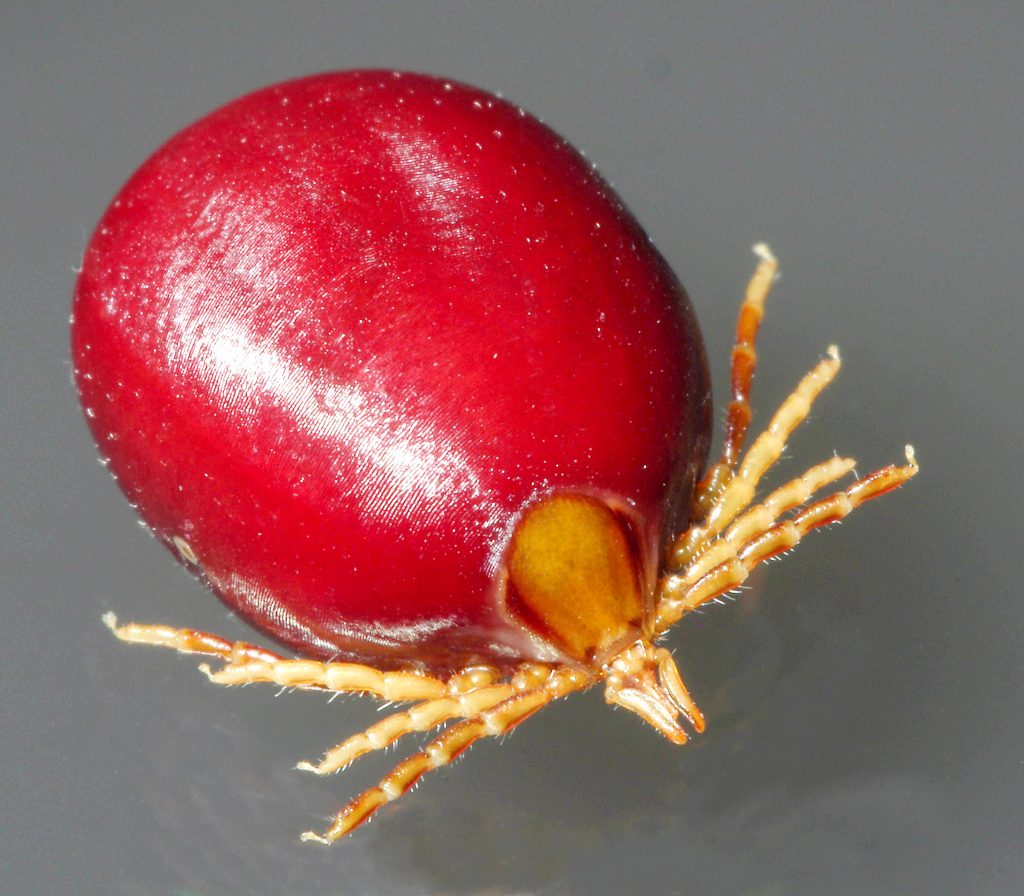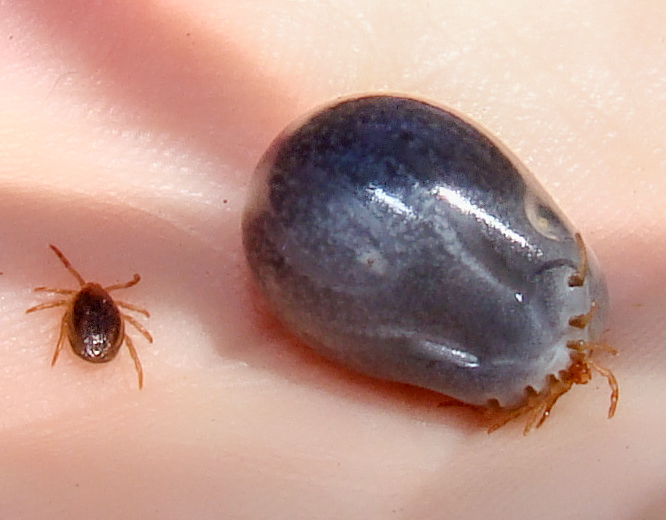A Northern Beaches-based allergy specialist has broken new ground in the fight against Mammalian Meat Allergy (MMA), helping to identify a sugar molecule that the body’s immune system interacts with when it triggers allergic responses.
Professor Sheryl van Nunen, an allergy specialist at Northern Beaches Hospital, and a co-author on the Garvan Institute run study, published last month in the journal Proceedings of the Academy of Science (PNAS), was the first clinician to link tick bites with mammalian-meat allergy.
“There isn’t a week go by that I wouldn’t see two people with this allergy,” she says.

Mammalian-meat allergy – MMA – is a potentially life-threatening condition that continues to rise along the Northern Beaches, which is already regarded as a global ‘hot-spot’.
Our region has the highest incidence of MMA in the world, with at least 1800 reported cases.
From relatively few cases prior to 2003, the number of MMA hospital admissions on the Northern Beaches has accelerated over the past two decades.
The continued increase in MMA on the Northern Beaches – which in some circumstances has been described as an ‘epidemic’ – means patients admitted to hospitals with anaphylaxis are now automatically treated as mammalian-meat allergy cases until diagnosis confirms otherwise.
What is Mammalian Meat Allergy?
Imagine if you are a carnivore, yet one day, inexplicably, you suddenly discover you are allergic to meat. Not chicken or fish but, specifically, mammal meat, including beef, lamb, pork and the less common or more ‘exotic’ dishes like goat, rabbit, venison, and camel. Furthermore, your unprecedented allergic reaction is so severe it triggers unpleasant symptoms, ranging from stomach cramps, diarrhea and hives to, in some cases, anaphylactic shock.

Dairy products or food containing animal by-products, like gelatine, are now off the menu for you too.
All because of a tick bite.
Exposure happens when α-gal, present in the saliva of certain tick species, is injected during a bite, Professor van Nunen explains.
Why some people develop anaphylaxis and others never respond is unknown. Professor van Nunen says it could be related to the number of tick bites, how much saliva is injected or genetic sensitivity.
About one-third of people who have developed a sensitivity to α-gal will exhibit symptoms of an allergy to mammalian meat, she says.
And another bite can more than double the allergic response. Some people with severe allergy can be affected by the presence of meat products in food, like beef broth, soft cheeses such as feta or goat’s cheese, or even gelatin.
After an initial reaction to the paralysis tick bite, does the recipient develop mammalian-meat allergy within days or months, or does it vary?
“It varies according to the person,” Prof van Nunen says. “For some people it’s within two weeks or a month; it depends on how much meat they eat, but there are other factors affecting allergic reactions in general and these are often linked to exercise and alcohol…
“And then it depends on how much meat they have, when they have it, if and when they exercise, if they drink alcohol with it, put chilli all over it, have a large amount, have it slow-roasted to let the allergen out, are premenstrual, had a Nurofen the day before, and a cold week before that…. They all pile on the amplifying factors…
“One of the curious things about this condition is that not everybody who has the allergy antibody reacts.
“One of the curious things about this condition is that not everybody who has the allergy antibody reacts.
“With the movement back to eating the whole animal, there may well be consequences and we do impress our patients who have this MMA problem that ‘offal is awful’, in that it’s supercharged with the allergen alpha-gal.
What can happen to you?
Anaphylaxis, which is very serious, and can include rapid increase of the heartbeat, difficulty breathing, fainting or going into shock. But the response is incredibly varied.
We spoke with three locals with three very different experiences of MMA.
Meet the Northern Beaches victims of Mammalian Meat Allergy
Katie Kimmorley

Katie Kimmorley, a 23 year old woman from Newport, has been living with the Mammalian Meat Allergy for the past four years. What started as an itchy tick bite in 2018 has now evolved into a lifestyle of constant vigilance, with anaphylactic reactions sending her to the hospital as recently as last week.
“People think that we’re paranoid vegetarians, but I wish more people knew how serious it is,” Katie said.
Katie believes she was bitten in the Dearin reserve near Newport while walking her dog in early August of 2018. At first there was no reaction, but two weeks after discovering the tick while out at dinner, her symptoms started.
“I woke up one morning and was covered head to toe in hives – I thought it was just a heat rash and didn’t think much of it. From there on I started to get quite sick: feeling nauseous, high temperatures. From then, every time I would eat meat something would happen. Each time it got progressively worse,” she said.
After receiving an inaccurate diagnoses from a GP, she saw Clinical Professor Sheryl Van Nunen, who accurately explained the nature of her allergy and provided her with the tools needed to manage her new lifestyle.
“I had cards to give to chefs so that they knew what I could eat,” said Katie. “I carry four epipens around with me constantly and it can get a bit embarrassing explaining it to new people every time.”
“I had cards to give to chefs so that they knew what I could eat.”
MMA has affected her lifestyle dramatically, limiting her from eating at almost every establishment due to a proven scepticism around whether those handling her food were taking the necessary precautions to ensure no meat products were touching her meal.
Although the allergy has limited how Katie can socialise, she’s not letting it take control of her life, and she wants to let others know that they can still live theirs while managing this allergy.
“I want to find someone to relate to, to read a story online and see someone experiencing something like me. I want people to know that while it’s still a big part of my life, [MMA] doesn’t have to rule your life.”
Mandy Holloway (Kevin Holloway)

Mandy Holloway, who had been living with MMA for the past 18 years, passed away in April of this year while in Canada due to anaphylaxis. She was 62 and did not come into contact with any triggers when she had her fatal reaction. Her husband, Kevin Holloway, agreed to speak with us so that more people could be aware of the effects of the allergy.
Having lived in Elanora Heights, ticks were a common occurrence, and it was not a shock when Mandy was bitten in 2003.
“We think it was around Narrabeen Lake, but we have ticks in our yard, so we couldn’t be totally accurate about that,” Kevin said. “She was bitten on a Thursday, and when I came home on the Sunday it was the first time she went into anaphylaxis, well, we assumed anaphylaxis at that point, but we didn’t know for sure for three episodes. I thought she was having a stroke.”
Because some doctors don’t know to test for MMA in patients, it can often go undiagnosed or misdiagnosed. Like Katie, the Holloways weren’t able to find many resources online about the allergy.
‘It took three episodes over three or four months to get a diagnosis. We took her to intensive care and they didn’t know what it was, and they sent her home thinking it was septicaemia or something, but they didn’t have a clue. They said the likelihood of her having that again was less than if she was struck by lightning, and it happened again within a month.”
“They said the likelihood of her having that again was less than if she was struck by lightning, and it happened again within a month.”
“It was very difficult managing it, as Mandy had an additional condition, being systemic mastocytosis, which is another level of anaphylaxis, and supposedly didn’t require triggers. Her body could just administer histamines without a trigger. We never had that instance until the fatal episode in April.”
Much like Katie, the Holloways experienced the same scepticism when eating out, as they experienced instances of finding triggers for the allergy from “fast food places all the way to five star restaurants”.
It is important to note that Mandy’s triggers included chilli and capsicum as well as kinds of red meat, highlighting the importance of public awareness for this allergy and the unique ways in which it can affect individuals.
Frank Geddes

Frank Geddes, a 58 year old man from Avalon, lived with MMA for just over two years before it mysteriously went away. Having been bitten in 1995 in his garden in Clareville, Geddes had even less access to information that what’s available today, and experienced the still common issue of being misdiagnosed.
“When I had it in 1995, I went to the doctor thinking it was an allergy I’d gotten from these tick bites, as that’s where the swelling would come up, but the doctor said “no, no, that doesn’t happen”, Frank said.
“If I came into contact with any red meat, except for kangaroo, I would get inflammation in the two spots where I was bitten by the tick, one on the neck and one on the groin, and they’d swell up quite a lot. I’d get a bit of swelling in the throat too which would make it hard to breathe.”
It wasn’t until two months after his first reaction when Frank saw an allergist and received an accurate diagnoses.
“I went to an allergist on the North Shore who conducted a test with a sample of beef, lamb and pork scrapped against my skin, and they call came up with the tell-tale lumps.”
“She said to me ‘you may or may not be allergic to this for the rest of your life. Your body changes a lot more on the inside than the outside, so don’t think that this is going to be forever.’ I didn’t take any notice of that cause I thought I’d have it forever. Two years later, I introduced a bit of meat into my diet and I didn’t have a reaction” he said.
Luckily, Frank has not had any allergic reactions since his two years in the nineties, even after being bitten by a tick again earlier this month.
How did Mammalian Meat Allergy come about?
“I first saw somebody [with MMA] in 1987,” Prof van Nunen reveals, “and then I really didn’t see many people at all until 2003, when it started to take off.. This coincided with the program of 1020 bait used to exterminate feral foxes. With foxes being removed, the tick had to find a new host…
“The bandicoots increased but they’re probably not the biggest cause of an acceleration in ticks, it’s probably black rats and rabbits.”
From relatively few cases prior to 2003, the number of MMA hospital admissions on the Northern Beaches has accelerated over the past two decades as housing developments advanced along the peninsula. Earlier this century, Bayview was identified as an area of concern as new homes were built in bushland overlooking Pittwater.
And therein lay the problem.
Prof van Nunen, then a Senior Staff Specialist in the Department of Clinical Immunology and Allergy at Royal North Shore Hospital, was concerned about the alarming increase in MMA-affected clients attending her clinic, so she set about researching the cause.
In 2007 Prof van Nunen revealed the results of her ground-breaking studies, identifying a particular species of parasite as the cause of mammalian meat allergy – Ixodes holocyclus – the paralysis tick, already familiar to pet owners whose dogs and cats were harmed by its bite.

Except it’s not just the bite, but the saliva in the tick’s mouth that is the danger.
This sialome – the proteins expressed in the salivary glands of ticks and other blood-sucking parasites – varies between different species of ticks, and scientists suspect the alpha-gal protein is not produced by the paralysis tick but a remnant from its last meal, such as a kangaroo or rabbit.
Are there other creatures triggering meat allergy?
“In 2022 there are 29 countries reporting it in about 15 different ticks,” Prof van Nunen reveals. “However, in sub-Saharan Africa, research indicates MMA is being transmitted by Ascaris lumbricoides, the helminth parasitic intestinal worm.”
Hope for Mammalian Meat Allergy (MMA) cure
The new research revealed in July 2022 details how human antibodies interact with the sugar molecule galactose-α-1,3-galactose (also known as alpha-gal or α-gal, hence how the disorder came to be known in America as Alpha-gal Syndrome). One particular antibody, 3-7, has been identified as the key responder to alpha-gal.

Prof Daniel Christ, Head of Antibody Therapeutics at Garvan Institute, who co-authored the research with Prof van Nunen, explains their discovery.
“We have more than 70 types of antibodies and this one is significantly overrepresented with α-gal recognition. We seem to be genetically predisposed to being sensitive to this sugar.”
Prof van Nunen adds: “This ground-breaking new research may well lead to treatments.”
“However, the situation in Australia is: you don’t get MMA if you don’t have a tick bite. If you don’t get another tick bite, you have a significant reduction in your levels over 18 months to two years.
“The cure for it is no more tick bites at any stage in life. Within three to four years, many people with MMA can return to eating meat. People just need to be savvy about what they do with ticks.”

So, prevention is better than cure. Anything you’d like to add?
“The government has spent an awful lot of money on ensuring that our tick does not carry Lyme disease but they have yet to spend a single cent in working out how frequent and prevalent mammalian-meat allergy or alpha-gal sensitisation is…”
“The government has spent an awful lot of money on ensuring that our tick does not carry Lyme disease but they have yet to spend a single cent in working out how frequent and prevalent mammalian-meat allergy or alpha-gal sensitisation is…”
Prevention of MMA
ASCIA (Australasian Society of Clinical Immunology and Allergy – the peak professional body of clinical immunology/allergy specialists in Australia and New Zealand) lists a number of recommendations on its website.
* Wear long-sleeved shirts tucked into long trousers and tuck trouser legs into long socks.
* Wear a wide-brimmed hat.
* Wear light-coloured clothes, which makes it easier to see ticks.
* Undress and check for ticks daily, checking carefully in the neck and scalp.
* Use insect repellent that contains DEET [diethyltoluamide] eg: RID, Aerogard or Bushmans.
Carry a canister of tick freezing spray.
If a tick has bitten you, picking it off with tweezers, or grabbing it between fingers and yanking it, is strongly discouraged! This may cause it to regurgitate toxic saliva into the bite wound.

Instead, freeze it with a dedicated spray, which, at -10 to -20 °C, kills the tick immediately so it can be brushed off.
Brands include TickTox, Medi Freeze Tick Off, or several wart freezing sprays that use liquid nitrogen.
Sydney’s peak tick season typically extends from late August to March each year.
More information about how to avoid or manage a tick bite can be found at www.tiara.org.au.
This article has been written and researched by Alec Smart, James Murray, and Kim Smee.



